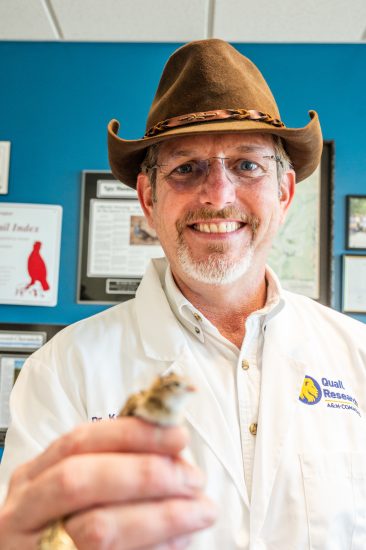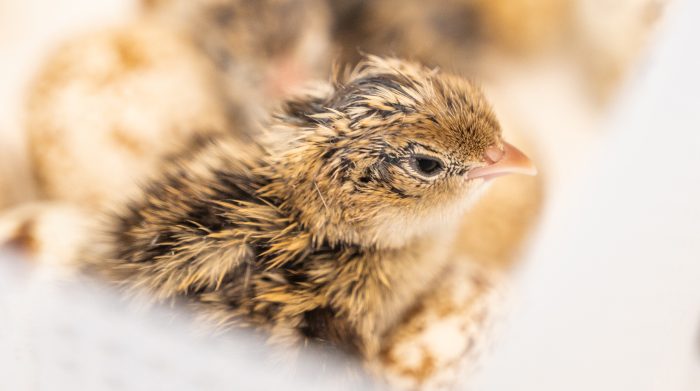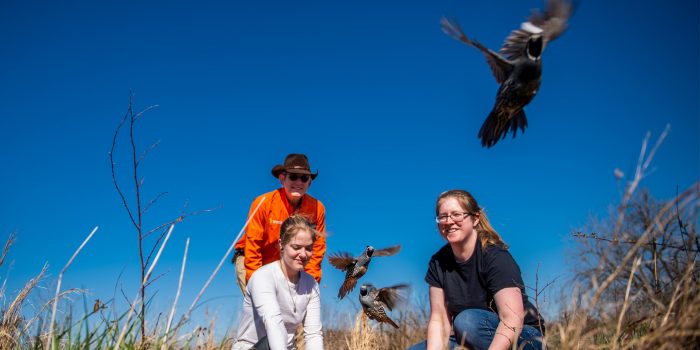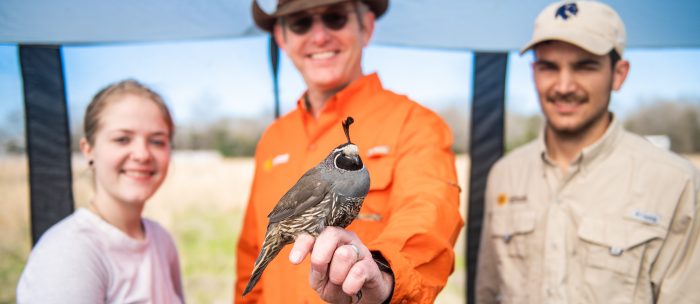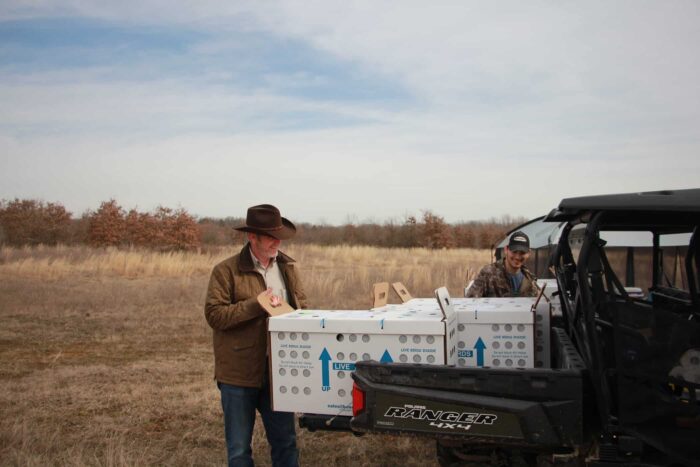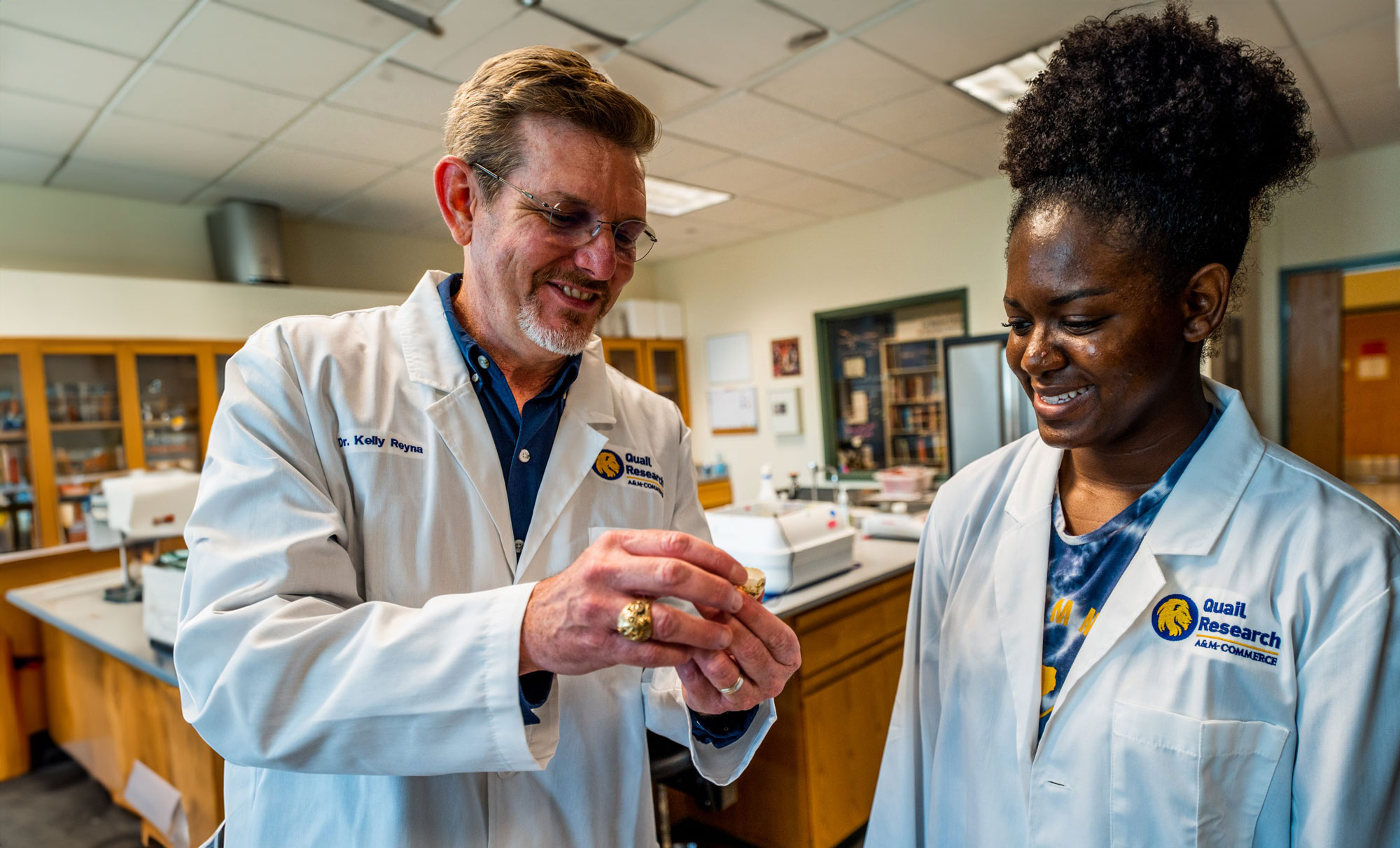
- On this page:
-
 Abstract
Abstract
-
 Featured Publication
Featured Publication
-
 Featured News Quail
Featured News Quail
Quail Chick Development
Sustainability Begins in the Egg
Sustainable quail populations are dependent on chick development, hatching, and recruitment. Extreme climate, like drought, and management efforts, like spraying pesticides during nesting season have negative impacts. The Quail Research Laboratory includes world-class facilities to investigate factors that influence quail development and population sustainability.
Abstract
Quail species develop differently due to genetics, epigenetics, and environment. To determine if quail embryos and eggs are affected by environmental change, normal stages of development for each species must first be described to compare to experimental results. Scientists from The Quail Research Laboratory recently charted the normal stages of development for the California Valley quail and continue to chart other quail species.
Featured Publications
Perry, S.M., J.G. Whitt, and K.S. Reyna. 2022. The normal stages of development for the California valley quail. PLOS ONE. https://doi.org/10.1371/journal.pone. 0268524.
Temperature extremes alter development, growth, hatching, and survival of eggs of ground-nesting birds, particularly during pre-incubation (egg laying) when eggs are left unattended and exposed to the environment for days or weeks before parental incubation begins. The northern bobwhite quail is a ground-nesting bird whose eggs experience high temperatures (≥45° C) during pre-incubation. It is known that chronic high temperatures during pre-incubation alter development and reduce hatching and survival of bobwhite eggs, but it is not known if acute doses of high temperatures during pre-incubation have the same effect. In this study, the 12-d pre-incubation period was divided into thirds. Fresh bobwhite eggs were exposed to either a commercial holding temperature for all 12 d (serving as a control), or a high oscillating temperature regimen for 4 d (one third of pre-incubation) either in the early, middle, or late third of pre-incubation, with a low oscillating temperature regimen during the remaining 8 d. The timing of acute exposure to high oscillating temperatures significantly affected bobwhite development. Eggs exposed in the first 2/3 of pre-incubation developed twice as much as eggs exposed late in pre-incubation, even though all eggs received the same amount of heating degree-hours. Thus, a critical window of thermal susceptibility exists for developing northern bobwhites. Acute exposure to high oscillating temperatures resulted in reduced hatchling mass, hatching success, survival, and compromised hatching synchrony. Thus, acute hyperthermic nest temperatures during pre-incubation could result in the observed reductions in the percentage of juveniles in natural populations during hot and droughty years.
Global warming is likely to alter reproductive success of ground-nesting birds that lay eggs normally left unattended for days or even weeks before actual parental incubation, especially in already warm climates. The native North American bobwhite quail (Colinus virginianus) is such a species, and pre-incubation quail eggs may experience temperatures ≥45°C. Yet, almost nothing is known about embryonic survival after such high pre-incubation temperatures. Freshly laid bobwhite quail eggs were exposed during a 12 day pre-incubation period to one of five thermal regimes: low oscillating temperatures (25–40°C, mean = 28.9°C), high oscillating temperatures (30–45°C, mean = 33.9°C), low constant temperatures (28.85°C), high constant temperatures (mean = 33.9°C), or commercially employed pre-incubation temperatures (20°C). After treatment, eggs were then incubated at a standard 37.5°C to determine subsequent effects on embryonic development rate, survival, water loss, hatching, and embryonic oxygen consumption. Both quantity of heating degree hours during pre-incubation and specific thermal regime (oscillating vs. non-oscillating) profoundly affected important aspects of embryo survival and indices of development and growth Pre-incubation quail eggs showed a remarkable tolerance to constant high temperatures (up to 45°C), surviving for 4.5±0.3 days of subsequent incubation, but high oscillating pre-incubation temperature increased embryo survival (mean survival 12.2±1.8 days) and led to more rapid development than high constant temperature (maximum 38.5°C), even though both groups experienced the same total heating degree-hours. Oxygen consumption was ~200–300 μl O2.egg.min-1 at hatching in all groups, and was not affected by pre-incubation conditions. Oscillating temperatures, which are the norm for pre-incubation quail eggs in their natural habitat, thus enhanced survival at higher temperatures. However, a 5°C increase in pre-incubation temperature, which equates to the predicted long-term increases of 5°C or more, nonetheless reduced hatching rate by approximately 50%. Thus, while pre-incubation bobwhite eggs may be resilient to moderate oscillating temperature increases, global warming will likely severely impact wild bobwhite quail populations, especially in their strongholds in southern latitudes.
Since their emergence in the early 1990s, neonicotinoid use has increased exponentially to make them the world’s most prevalent insecticides. Although there has been considerable research concerning the lethality of neonicotinoids, their sub-lethal and developmental effects are still being explored, especially with regard to non-mammalian species. The goal of this research was to investigate the effects of the neonicotinoid imidacloprid on the morphological and physiological development of northern bobwhite quail (Colinus virginianus). Bobwhite eggs (n=390) were injected with imidacloprid concentrations of 0 (sham), 10, 50, 100, and 150mg/kg of egg mass, which was administered at day 0 (pre-incubation), 3, 6, 9, or 12 of growth. Embryos were dissected, weighed, staged, and examined for any overt structural deformities after 19days of incubation. The mass of the embryonic heart, liver, lungs and kidneys was also recorded. The majority of treatments produced no discernible differences in embryo morphology; however, in some instances, embryos were subject to increased frequency of anatomical deformity and altered organ masses. Some impacts were more pronounced in specific dosing periods, implying that there may be critical windows of development when embryos are more susceptible to neonicotinoid exposure. This investigation suggests that imidacloprid has the potential to impact bobwhite quail embryonic development and chick survival.
Humans have employed chemical methods of pest control since the earliest days of agriculture and these substances have affected native wildlife, including quail and other gamebirds (Galliformes), to varying degrees. Several quail species have experienced steep population declines over the past several decades and insecticides may be a contributing factor. Quail are also known to use agricultural habitat for nesting and foraging purposes and are therefore likely to encounter elevated levels of insecticidal chemicals in the soil, vegetation, and insect biomass in that environment. The first commercially available insecticides appeared in the early 1900s with the introduction of arsenic-based compounds (arsenicals). Chemical engineering during World War II resulted in arsenicals being replaced with synthetically produced insecticides such as organochlorine, carbamate, and organophosphate compounds over several decades. Many of these substances have been shown to increase mortality rate, alter behavior, and produce severe reproductive complications in quail, both in the lab and the field. Today, the world's most popular insecticides, neonicotinoids, are being reevaluated for environmental safety following reports that they may be affecting nontarget wildlife. This review examines the types of insecticides that have been used in the United States, how quail could be exposed to these substances, and how they may have contributed to declining quail populations.
Northern Bobwhite eggs in the southern United States are often exposed to ambient temperatures in excess of their normal incubation temperature when unattended during their typical extended preincubation period. In drought years, typified by high ambient temperatures, Bobwhite eggs are often exposed to temperatures >45°C, well-above the upper lethal temperature of most other birds. Because the upper lethal temperature of Bobwhite embryos is not currently known, simulated clutches of eggs were exposed to preincubation temperatures ranging from 39 to 52°C for exposure times of 1, 3, or 6 h. The upper lethal temperatures and the temperatures resulting in ≥50% death of Northern Bobwhite embryos were recorded in addition to the time to thermal equilibrium of Bobwhite eggs. The upper lethal temperature for 1, 3, and 6 h of preincubation exposure was 51, 49, and 46°C, respectively. The temperatures resulting in ≥50% death were 46, 44, and 40°C for eggs exposed to elevated temperatures for 1, 3, and 6 h, respectively. The mean time for the inner-egg temperature to reach the ambient temperature was 38 ± 1 min (± SE). The thermal tolerances of Northern Bobwhite embryos were much higher than expected, and among the highest reported for birds, indicating an adaptation to the naturally occurring temperature extremes that often occur in the Bobwhite’s semi-arid southern range. However, as the temperature increased above the incubation temperature, hatching success declined, showing that increased thermal tolerance has a cost. Although Bobwhite producers, managers, and researchers will find this information useful, it seems most interesting that high temperatures could plausibly have contributed to the population decline observed in the Bobwhite’s semi-arid range.
Embryo-environment interactions affecting cardio-respiratory development in vertebrates have been extensively studied, but an equally extensive conceptual framework for interpreting and interrelating these developmental events has lagged behind. In this review, we consider the conceptual constructs of “developmental plasticity”, “critical windows”, “developmental trajectory” and related concepts as they apply to both vertebrate and invertebrate development. Developmental plasticity and the related phenomenon of “heterokairy” are considered as a subset of phenotypic plasticity, and examples of cardiovascular, respiratory and metabolic plasticity illustrate the variable outcomes of embryo-environment interactions. The concept of the critical window is revealed to be overarching in cardio-respiratory development, and events originating within a critical window, potentially mitigated by “self-repair” capabilities of the embryo, are shown to result in modified developmental trajectories and, ultimately, modified adult phenotype. Finally, epigenetics, fetal programming and related phenomena are considered in the context of potentially life-long cardio-respiratory phenotypic modification resulting from embryo-environment interactions.






